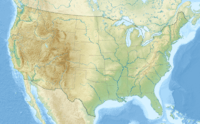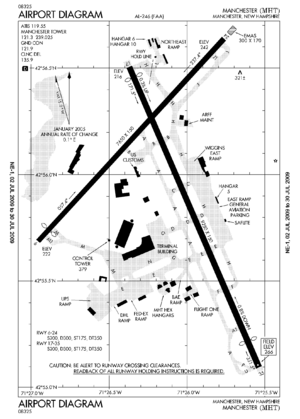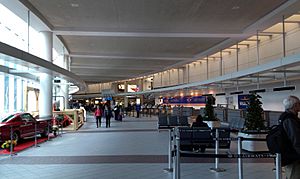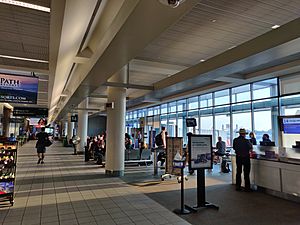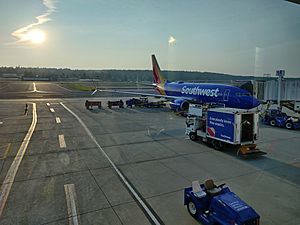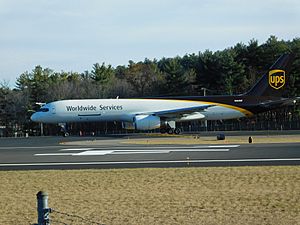Manchester–Boston Regional Airport facts for kids
Quick facts for kids
Manchester–Boston Regional Airport
|
|||||||||||||||
|---|---|---|---|---|---|---|---|---|---|---|---|---|---|---|---|
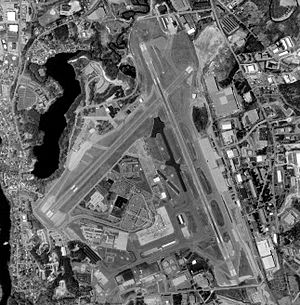
Air photo taken 11 April 1998
|
|||||||||||||||
| Summary | |||||||||||||||
| Airport type | Public | ||||||||||||||
| Owner | City of Manchester | ||||||||||||||
| Serves | Manchester, New Hampshire | ||||||||||||||
| Location | Manchester and Londonderry, New Hampshire, U.S. | ||||||||||||||
| Hub for | Wiggins Airways | ||||||||||||||
| Elevation AMSL | 266 ft / 81 m | ||||||||||||||
| Coordinates | 42°55′57″N 071°26′08″W / 42.93250°N 71.43556°W | ||||||||||||||
| Map | |||||||||||||||
| Runway | |||||||||||||||
|
|||||||||||||||
| Statistics | |||||||||||||||
|
|||||||||||||||
|
Source: Federal Aviation Administration
|
|||||||||||||||
Manchester–Boston Regional Airport (IATA: MHT, ICAO: KMHT, FAA LID: MHT), also known as Manchester Airport, is a public airport in New Hampshire, United States. It is located about 3 miles (5 km) south of downtown Manchester, New Hampshire. The airport is owned by the city of Manchester and sits on the border between Manchester and Londonderry.
Opened in 1927, Manchester–Boston Regional Airport is the busiest airport in New Hampshire. It is the only airport in the state with many commercial flights. It is also the fifth-largest airport in New England based on how many passengers it serves. In 1997, it served over 1 million passengers for the first time. Its busiest year was 2005, with 4.33 million passengers. Since then, like many smaller airports, its passenger numbers have gone down.
The airport was called Manchester Airport until April 18, 2006. Then, it added "Boston Regional" to its name to show that it is close to Boston, which is about 50 miles (80 km) south. This airport is known for almost never closing due to bad weather. It has only closed once, after the September 11 attacks, when all U.S. airports had to shut down. The airport is also home to the Aviation Museum of New Hampshire.
Contents
What the Airport is Used For
Manchester–Boston is New England's third-largest airport for cargo (things shipped by air). It is behind Bradley International in Connecticut and Logan in Boston. Big shipping companies like FedEx and UPS use Manchester. They fly large cargo jets, like the Airbus A300 and Boeing 767, to this airport.
UPS uses Manchester to send packages to other parts of northern New England. They work with Wiggins Airways, which flies smaller planes to places like Portland, Augusta, and Bangor. UPS built a special sorting center at Manchester. Here, packages from their main hub in Louisville are sorted. They are then sent out by truck or on Wiggins feeder planes.
FedEx also used Manchester as a sorting station before. Now, they fly directly from Memphis, Tennessee to Portland and Burlington. The Postal Service also uses FedEx jets to send mail.
Airport Features and Daily Work
Manchester Airport covers a large area of 1,500 acres (610 ha). It has two asphalt runways. One runway is 9,250 feet long, and the other is 7,651 feet long. These runways are where planes take off and land.
In one recent year (ending April 30, 2021), the airport had 32,845 aircraft operations. This means about 90 planes took off or landed each day. About a third of these were commercial flights. The rest were air taxis, private planes (general aviation), and military flights. In November 2021, 89 aircraft were based at the airport. These included single-engine planes, multi-engine planes, jets, and helicopters.
Airport History
The Manchester airport started in June 1927. The city put $15,000 towards building it. By October, a special aviation board was created, and work began on an 84-acre (34 ha) site. It took only one month to build two 1,800-foot (550 m) runways. The first flying service in Manchester began soon after. In 1933, Northeast Airways started, and the first passenger building was built.
In 1940, during World War II, the airport became an Army Air Force base. About 6,000 troops were stationed there. It was renamed Grenier Field after Lt. Jean B. Grenier, a Manchester native who died in 1934. After the war, civilian flights returned in 1951.
In the 1960s, the airport began to grow as a place for both civilian and military planes. A new civilian terminal and the first modern air traffic control tower in New Hampshire were built in 1961. In 1966, the Air Force left, allowing the airport to expand more. In 1978, it was officially renamed Manchester Airport.
Through the 1960s and 1970s, airlines like Northeast Airlines and Delta Air Lines served the airport. They used planes like the Douglas DC-9 and Boeing 727.
In the mid-1980s, jet service returned to Manchester. United Airlines started flights to Chicago–O'Hare in 1983. This was part of their plan to serve all 50 states. US Airways also began service in 1986, connecting Manchester to their hubs in Pittsburgh and Philadelphia. Over the years, these airlines added more flights and used larger planes. The Boeing 757 has been the largest passenger plane to regularly serve the airport.
Today, several airlines serve Manchester. Spirit Airlines began service in October 2021, flying to four cities in Florida. Southwest uses Boeing 737 planes. American also flies from Charlotte.
Airport Growth and Changes
In 1992, a big plan to expand and improve the airport began. Two years later, a new terminal building opened. It was 158,000-square-foot (14,700 m2) and had plenty of space for bigger jets. The airport continued to grow, adding new parking areas. They also rebuilt the runways and taxiways.
These improvements helped the airport a lot. In 1998, MetroJet, Northwest, and Southwest all started flying from Manchester. The airport became very popular because of the "Southwest Effect". This is when a low-cost airline starts flying to an airport, and other airlines lower their prices and add more flights to compete. In the 1990s, Manchester grew faster than almost any other airport its size. In 2003, one of the runways was made longer, allowing non-stop flights to places like Las Vegas.
In April 2006, the city leaders of Manchester voted to change the airport's name to "Manchester–Boston Regional Airport". This was done to make more travelers across the country aware of the airport.
Fewer Passengers Over Time
After 2005, the number of passengers flying through Manchester Airport started to go down. By 2017, the airport served the fewest passengers since 1998. Airlines like Southwest and Delta Air Lines reduced their flights. For example, United Airlines stopped its flights to Chicago–O'Hare in 2018.
This drop in passengers is partly because Logan International Airport in Boston became more active. Also, airlines merged, which sometimes led to fewer flights from smaller airports. When Southwest started flying from Logan in 2009, it made prices at Logan much cheaper. This caused more people to choose to fly from Boston instead of Manchester.
Current Flights and Future Plans
In 2019, American Airlines announced new service to Chicago O'Hare. United Airlines also changed its service to Washington-Dulles.
The airport has a new director who is working to bring back passengers and attract new airlines and destinations. In November 2020, Delta Airlines announced they would stop service to Manchester. However, in June 2021, Spirit Airlines announced they would start flying to four Florida cities from Manchester. Spirit is the first new airline to start service at Manchester–Boston since Air Canada in 2004.
In November 2021, it was announced that United Airlines would stop service to Washington Dulles in January 2022. This means Newark will once again be the only destination from Manchester on United.
Airlines and Destinations
Passenger Flights
| Airlines | Destinations |
|---|---|
| American Airlines | Seasonal: Charlotte (begins June 3, 2022) |
| American Eagle | Charlotte, Chicago–O'Hare, Philadelphia, Washington–National |
| Southwest Airlines | Baltimore, Chicago–Midway, Orlando, Tampa |
| Spirit Airlines | Fort Lauderdale, Orlando, Seasonal: Fort Myers, Tampa, Myrtle Beach |
| United Express | Newark |
Cargo Flights
| Airlines | Destinations |
|---|---|
| FedEx Express | Memphis Seasonal: Boston, Buffalo, Greensboro, Hartford, Indianapolis, Newark, Philadelphia, Portland (ME) |
| Freight Runners Express |
Portland (ME), Presque Isle, Waterville (ME) |
| Legacy Airways |
Burlington (VT) |
| UPS Airlines | Louisville, Philadelphia Seasonal: Bangor, Boston, Chicago/Rockford, Cleveland, Columbia, Gary, Hartford, Miami, Ontario, Syracuse |
| Wiggins Airways |
Auburn, Bangor, Barre/Montpelier, Burlington (VT), Newark, Portland (ME), Presque Isle, Rockland, Rutland, Waterville (ME) |
Airport Statistics
Most Popular Destinations
| Rank | Airport | Passengers | Carriers |
|---|---|---|---|
| 1 | Baltimore, Maryland | 144,630 | Southwest |
| 2 | Charlotte, North Carolina | 67,030 | American |
| 3 | Orlando, Florida | 59,300 | Southwest,Spirit |
| 4 | Philadelphia, Pennsylvania | 51,540 | American |
| 5 | Chicago–Midway, Illinois | 42,870 | Southwest |
| 6 | Chicago–O'Hare, Illinois | 28,480 | American |
| 7 | Washington–National, D.C. | 30,000 | American |
| 8 | Washington–Dulles, D.C. | 22,070 | American |
| 9 | Tampa, Florida | 12,000 | Southwest, Spirit |
| 10 | Fort Lauderdale, Florida | 7,140 | Spirit |
| Carrier | Passengers (arriving and departing) |
|---|---|
| Southwest |
507,000(53.14%)
|
| PSA |
174,000(18.20%)
|
| Republic |
68,040(7.17%)
|
| Piedmont |
65,940(6.91%)
|
| Wisconsin |
43,620(4.57%)
|
| Other |
95,950(10.05%)
|
Yearly Passenger Numbers
| 1990s | 2000s | 2010s | 2020s | ||||||||
|---|---|---|---|---|---|---|---|---|---|---|---|
| Year | Passengers | Change | Year | Passengers | Change | Year | Passengers | Change | Year | Passengers | Change |
| 2000 | 3,169,301 | 2010 | 2,814,432 | 2020 | 634,841 | ||||||
| 2001 | 3,233,555 | 2011 | 2,710,747 | 2021 | 944,147 | ||||||
| 1992 | 840,361 | 2002 | 3,366,834 | 2012 | 2,452,064 | ||||||
| 1993 | 794,134 | 2003 | 3,601,661 | 2013 | 2,422,102 | ||||||
| 1994 | 919,914 | 2004 | 4,003,307 | 2014 | 2,095,674 | ||||||
| 1995 | 893,326 | 2005 | 4,329,478 | 2015 | 2,077,064 | ||||||
| 1996 | 984,130 | 2006 | 3,896,532 | 2016 | 2,021,279 | ||||||
| 1997 | 1,108,216 | 2007 | 3,892,630 | 2017 | 1,970,688 | ||||||
| 1998 | 1,938,089 | 2008 | 3,716,393 | 2018 | 1,847,908 | ||||||
| 1999 | 2,809,089 | 2009 | 3,181,249 | 2019 | 1,727,532 | ||||||
Getting To and From the Airport
Road Access
In 2007, work began on a new road called Raymond Wieczorek Drive. This road connects the airport directly to the F.E. Everett Turnpike. Before this, you could only get to the airport using local roads. The new access road opened on November 10, 2011. It connects the airport and NH Route 3A in Litchfield to the Everett Turnpike and U.S. Route 3 in Bedford.
Shuttle Services
From 2006 to 2008, the airport offered a free shuttle bus for passengers. It ran every two hours to places like Woburn, Massachusetts and a subway station in Boston. This free service stopped when a private company, Flight Line Inc., started a paid service in July 2008. Flight Line now offers hourly service between the airport and several spots in northern Massachusetts and Boston.
Bus Services
Greyhound buses offer three trips daily from Manchester Airport. These buses are part of their service between Boston and Montreal. Northbound buses go to places like Concord and Hanover in New Hampshire, and several cities in Vermont and Canada. Southbound buses go to South Station and Logan International Airport in Boston.
The Manchester Transit Authority also provides hourly bus service. This local bus connects the airport terminal to downtown Manchester.
Future Train Plans
The Massachusetts Bay Transportation Authority has suggested extending its commuter train system to Manchester. This would include a stop at Manchester airport. However, this is just a plan for now, and no money has been set aside for the project.
Airport Security
The Londonderry Police Department is in charge of law enforcement and security at the airport terminal. They took over this job in 2006.
Solar Panels at the Airport
In 2012, solar panels were put on the roof of the airport's parking garage. These panels faced south. However, they caused a lot of glare for the nearby control tower every morning. Because of this, they were removed. Later, 2,210 new panels were installed. These new panels were turned to face east to stop the glare.
The airport expects to save $100,000 each year on electricity because of these solar panels. Even though east-facing panels are a bit less efficient, more panels were added to make sure the airport still produces a lot of electricity. The solar array is expected to generate about 585,000 kilowatt-hours of electricity each year.
Images for kids
See also
 In Spanish: Aeropuerto Regional de Mánchester-Boston para niños
In Spanish: Aeropuerto Regional de Mánchester-Boston para niños



